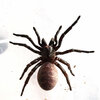KyleGu3
Arachnopeon
- Joined
- Oct 15, 2022
- Messages
- 3
Chawakorn Kunsete et al. Zootaxa. 2020
Somewhat recently (re)described species in the Bemmeridae family. Very similar in appearance to Atrax robustus. My specimen is approximately 7cm in DLS.
Immediately fossorial and took up residence at the bottom of its enclosure. Interesting behavior I found after allowing it to acclimate for ~2weeks: she is constantly excavating and I find her making her web tube/burrow very long. She is making a very thick web sock around herself as well. When she is caught on the surface, I found her to actively attack and kill any prey I give her but not eat. Her abdomen is growing so there may be a chance shes gravid.
Will update if there's any new developments. Enjoy some pictures!
Somewhat recently (re)described species in the Bemmeridae family. Very similar in appearance to Atrax robustus. My specimen is approximately 7cm in DLS.
Immediately fossorial and took up residence at the bottom of its enclosure. Interesting behavior I found after allowing it to acclimate for ~2weeks: she is constantly excavating and I find her making her web tube/burrow very long. She is making a very thick web sock around herself as well. When she is caught on the surface, I found her to actively attack and kill any prey I give her but not eat. Her abdomen is growing so there may be a chance shes gravid.
Will update if there's any new developments. Enjoy some pictures!
Attachments
-
256.9 KB Views: 117
-
661.9 KB Views: 124
-
647.8 KB Views: 116















